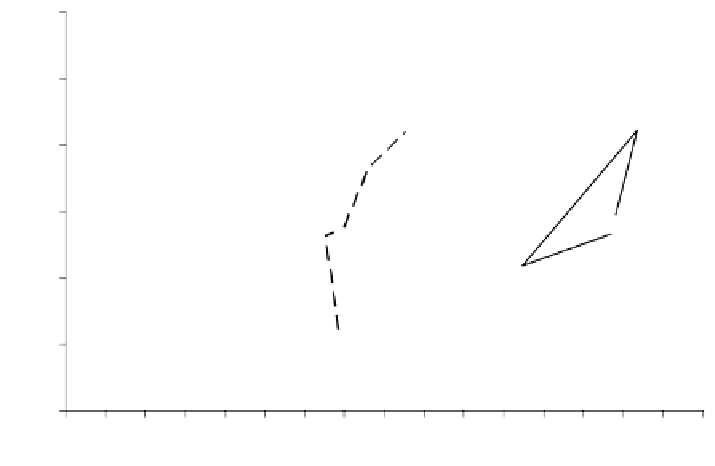Geoscience Reference
In-Depth Information
35
A
ugust
30
August
July
A
J
J
August
September
September
A
S
June
S
summer
M
25
J
J
O
May
S
June
O
April
20
May
O
spring
October
A
M
J
N
autumn
N
April
N
A
winter
M
M
15
D
D
D
March
1953
1974
1981
1991
1997
Mediterranean Sea
D
F
N
January
January
10
F
F
5
37
38
39
40
41
42
43
44
45
46
47
48
49
50
51
52
53
Salinity
FIGURE 9.3.7
Annual course of T-S index (monthly averaged values) for the Mar Menor
during the last decades, compared with the Mediterranean shallow coastal waters of the Cape
of Palos. Point at the right of the diagram corresponds to September and August monthly
mean values at the Mar Menor according to data from Lozano.
40
The progressive “mediter-
ranization” of the lagoon waters can be noted.
the same time covered by a dense meadow of the algae
Caulerpa prolifera
or
patches of the seagrass
Ruppia cirrhosa
. On the other hand, sandy bottoms (with
sand content up to 89%) are located on the margins of the basin and in the small
bays surrounding the islands in which scant patches of the phanerogame
Cymodocea
nodosa
grow.
The organic matter content in the sediment of the Mar Menor is highly variable,
ranging from less than 0.34% in compacted red clays up to 8.6% in the
Caulerpa
prolifera
areas. An increase in the organic matter content of sediment is observed
seasonally, from autumn to winter, in both muddy and sandy bottoms. This increase
is explained by the contribution of the fronds of the green algae
Caulerpa prolifera
and the phanerogame
Cymodocea nodosa
, respectively.
Dissolved oxygen values in sediment layers show a high range of variation
oscillating between values in the range of 5 to 11 mg/l in surface waters (depending
on wave action) to anoxic conditions and concentrations lower than 2 mg/l close to
the bottom, in areas with dense meadows on muddy bottoms, high concentrations
of organic matter, and low hydrodynamics. The water column shows homogeneous
values, usually over saturation, with a small maximum just over the meadow
(Table 9.3.2)
.
Such a situation, with saturation levels in surface waters and anoxic
conditions at the bottom, has been described previously in deeper lagoons.
12,15
Submerged aquatic vegetation, rather than physical factors, seems to play a major
role in the physical and chemical nature of sediment with only hydrodynamics

































































Search WWH ::

Custom Search